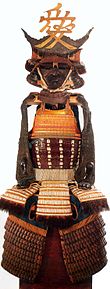
Naoe Kanetsugu
Share
Naoe Kanetsugu (直江 兼続; 1559 - January 23, 1620) was a Japanese samurai who lived from the Sengoku to Edo periods. The eldest son of Higuchi Kanetoyo, Kanetsugu is known for serving two generations of Uesugi daimyō.
He is also known by his court title, Yamashiro no Kami (山城守) or by his birth name, Higuchi Kanetsugu (樋口 兼続).
Kanetsugu first served Uesugi Kenshin as a koshō (小姓). After Kenshin's death he served his adopted son Kagekatsu. Kanetsugu's brother, Ōkuni Sanehiro, was also a famous Uesugi servant.
Naoe Kanetsugu Biography

Kanetsugu was born as Yoroku (与六) at Sakato Castle in Echigo Province. His father, Higuchi Sōemon Kanetoyo was an old servant of Nagao Masakage, the lord of Sakato Castle.
When Yoroku reached adulthood he married his first cousin Osen on his mother's side, the widow of the servant Uesugi Naoe Nobutsuna, and took the Naoe family name to become the head of the family since Osen had had no children from the previous marriage and thus had no heir with right of succession.
He became a Uesugi advisor at the age of twenty-two, quickly distinguishing himself as an outstanding commander, and was involved in many battles that took place in the Japan Sea coast with Sassa Narimasa and Maeda Toshiie.
Kanetsugu was also responsible for the actions of the Uesugi clan against the Tokugawa coalition during the maneuvers that ended with the siege of Hasedō.
Following the Uesugi clan's surrender to the Tokugawa in 1601, their properties were transferred to the smaller fief of Yonezawa, with revenues of 300,000 koku. Kanetsugu was guaranteed a stipend before retirement.
After Naoe Kanetsugu's death
After his death, his wife Lady Osen (お船), as was the custom of the time, took the tonsure, cut her hair, and became a Buddhist nun. Her name changed to Lady Teishin-ni (貞心尼). Teishin-ni still helped the young Uesugi chief, Uesugi Sadakatsu, until his death in 1637 at the age of 81.
Naoe Kanetsugu Personality
Naoe Kanetsugu was respected for his actions. In Walter and M.E. Dening's "The Life of Toyotomi Hideyoshi" there is an anecdote in which Hideyoshi, whose temporary unification of Japan had paved the way for the Tokugawa shogunate, decided to visit Uesugi Kagekatsu, at that time lord of Kanetsugu, accompanied by a few servants.
When he received the news, Kagekatsu called a council to discuss what was best to do under the circumstances. Most of the councilors lined up to assassinate Hideyoshi, arguing that it would be by far the easiest way to get rid of a dangerous enemy.
But Naoe Kanetsugu condemned this advice as unworthy of a man who held the position of Kagekatsu. "Hideyoshi coming among us without guards," said Kanetsugu, "is proof of his deep respect for our lord.
With lesser lords Hideyoshi would not expose himself so much to danger. Knowing that our lord is a man of noble character, he trusts us.
If we took advantage of that and killed him, the story of our cowardice and treachery would be handed down to posterity for our eternal shame. No: let our master meet magnanimity with magnanimity; let him have an audience with Hideyoshi and see if they cannot come to an agreement. If they will not, then we will fight, but not before Hideyoshi is sent home."

